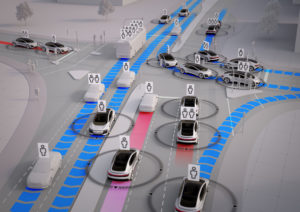 Study together with the AUDI AG and the Karlsruhe Institute for Technology (KIT) that analyzes traffic flow in the age of self-driving cars, changed user behavior and digital infrastructure via a broad impact assessment.
Study together with the AUDI AG and the Karlsruhe Institute for Technology (KIT) that analyzes traffic flow in the age of self-driving cars, changed user behavior and digital infrastructure via a broad impact assessment.
Therefore, various scenarios were considered (examples):
- Status Quo (Reflects the morning rush-hour in Ingolstadt with zero percent AVs today).
- Balance (Moderate changes in travel behavior and infrastructure and technology).
- Street Life (Best case scenario).
- Digital Detox (Worst case scenario).
- Shared Value (Scenario with an ambitious change in travel behavior and a strong acceptance of ride sharing).
- Delivery (Scenario with a high level of logistical traffic).
Modelling and simulation of future mobility in the city of Ingolstadt in the rush hour. Answering the question: “How many self-driving cars would be necessary to significantly improve the traffic flow?“
Consideration of the effects of:
- Autonomous vehicles
- New mobility services like ride sharing.
- Connected and intelligent traffic management.
- Technological and societal changes.
- Changes in user behavior.
- Increased traffic demand.
- Increase in the share of people who can participate in mobility.
These aspects were not only evaluated individually but it was examined how these effects interact in total and influence each other via the development of a vast impact assesment framwork.
Evaluated parameters (examples):
- Persons per vehicle.
- Innovations in traffic management.
- Distance travelled per person.
- AV share.
Analyzed indicators (examples):
- Travelers in the system.
- Time loss.
- Travel times.
Sources:
- Brochure [www.audi-mediacenter.com]
- Movie [www.audi-mediacenter.com]
- Interview [www.vimeo.com]
- Interactive Tool [https://25thhour.rndr.studio]
- Audi Mediacenter [www.audi-mediacenter.com]
- Engadget Article [www.engadet.com]
- Handelsblatt Article [www.handelsblatt.com]
- Greenpeace Magazin Article [www.greenpeace-magazin.de]




